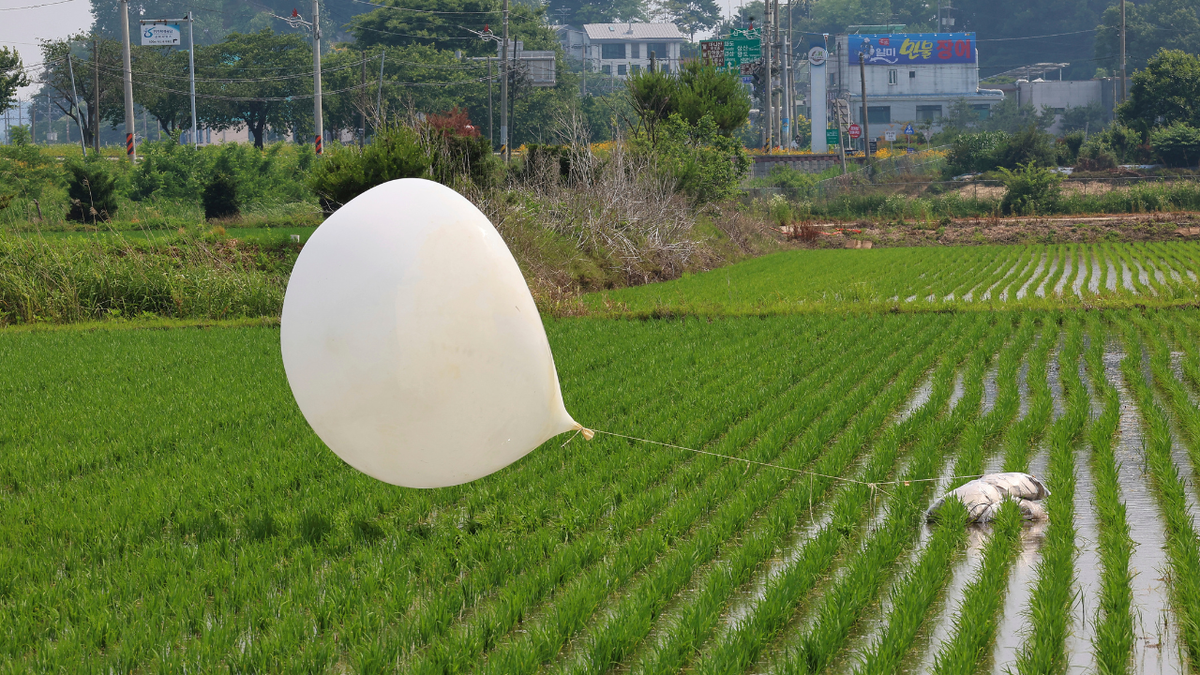- South Korea has threatened to resume anti-North Korea propaganda broadcasts after the North began releasing balloons carrying garbage across the border.
- North Korea released balloons filled with plastic bags filled with garbage in response to South Korean activists flying political leaflets.
- South Korea’s military said North Korea launched about 350 balloons, about 100 of which landed in Seoul and surrounding areas.
South Korea Front-line anti-Pyongyang threats to resume propaganda broadcasts on Tuesday came after North Korea resumed launching balloons carrying garbage, in the latest round of a Cold War-style campaign between the two rivals.
On Monday night, North Korea flew giant balloons loaded with plastic bags filled with garbage across the border, its fifth such operation since late May – an apparent response to South Korean activists flying political leaflets via balloons.
In a speech on Tuesday marking the anniversary of the Korean War, South Korean President Yoon Suk-yeol described North Korea’s balloon activities as “disgusting and irrational provocations.” He said South Korea would maintain firm military readiness to respond to any provocations by North Korea.
South Korea alerts for more North Korean trash balloons after threat of retaliation
Later on Tuesday, Yoon boarded a US aircraft carrier docked at a southeastern port and told US and South Korean troops there that the two countries’ alliance is the world’s greatest and can defeat any enemy. Yoon became the first South Korean president to board a US aircraft carrier since 1994.

South Korean President Yoon Suk Yeol (center right) and his wife Kim Kyon-hee wave the national flag during a ceremony marking the 74th anniversary of the start of the Korean War in Daegu, South Korea, June 25, 2024. (AP Photo/Ahn Young-joon, Pool)
South Korea’s military said North Korea launched about 350 balloons in its latest campaign, and about 100 of them eventually landed on South Korean soil, most of them in Seoul and surrounding areas. Seoul is about 25-30 miles from the border. The military said the trash carried by the North Korean balloons was mostly paper and no dangerous items were found.
In its earlier balloon launches, North Korea dropped manure, cigarette butts and spent batteries, as well as pieces of cloth and waste paper, over various parts of South Korea. No major damage was reported. In response, South Korea redeployed giant loudspeakers along the border on June 9 for the first time in six years and briefly resumed anti-North Korea propaganda broadcasts.
Joint Chiefs of Staff spokesman Lee Sung-joon told reporters on Tuesday that the South Korean military is ready to turn on its border loudspeakers again. The Joint Chiefs of Staff’s written statement said officials would investigate unspecified strategic and operational circumstances and the resumption of broadcasts would depend on how North Korea acts.

On June 10, 2024, a balloon was seen over a paddy field in Incheon, South Korea, possibly sent by North Korea. (Im Sun-suk/Yonhap via AP, File)
The psychological operations the two Koreas specialized in during the Cold War included balloon releases and loudspeaker broadcasts. In recent years the rival countries have agreed to halt such activities, but they have occasionally resumed when hostilities flare up again.
North Korea is highly sensitive to South Korean border broadcasts and civilian pamphlet-distribution campaigns because it restricts official access to foreign news for most of its 26 million people.
A leaflet-distribution campaign by civic activists in South Korea, most of them North Korean defectors, has included leaflets criticizing North Korea’s human rights abuses and USB sticks containing South Korean TV dramas, while previous broadcasts across the border from South Korea have included K-pop songs, weather forecasts and outside news. In a statement on Friday, Kim Yo Jong, the North Korean leader’s powerful sister, said the campaign was “looking forward to a place where you can get along with each other.” Kim Jong Uncalling them “human scum” and “disgusting turncoats”.
South Korean authorities say they are not preventing activists from sending leaflets to North Korea, in line with a 2023 Constitutional Court ruling that made sending such leaflets a crime and a violation of freedom of expression.

A visitor looks at the North Korean side from the Unification Observatory in Paju, South Korea on June 25, 2024. (AP Photo/Lee Jin-man)
Several experts say North Korea’s balloon campaign may be designed to intensify the debate over the distribution of leaflets to civilians in South Korea and foster wider internal divisions.
Concerns about North Korea grew in mid-June, when North Korean leader Kim Jong Un and Russian President Vladimir Putin signed an agreement that required each country to provide assistance if attacked and vowed to increase cooperation with the other. Observers say the agreement represents the strongest relationship between the two countries since the end of the Cold War.
The United States and its partners believe North Korea is providing Russia with badly needed conventional weapons for its war in Ukraine in exchange for military and economic aid.
In his speech on the Korean War, Yun described the Kim-Putin agreement as “anachronistic.” South Korea, the United States and Japan issued a joint statement on Monday strongly condemning growing military cooperation between Russia and North Korea.
Click here to get the Fox News app
The arrival of the USS Theodore Roosevelt carrier and its strike group is to address these challenges. of North Korea South Korean officials said their deployment is also part of a 2023 South Korea-US agreement to increase the “regular visibility” of US strategic assets in the Korean Peninsula due to the nuclear threat and growing military partnership with Russia.
Yun said the US aircraft carrier will leave a South Korean port on Wednesday and conduct a trilateral exercise between South Korea-US-Japan. The new multi-domain “Freedom Edge” exercise aims to sharpen the countries’ joint response in various areas of operations, including air, sea and cyberspace.
North Korea has previously responded to such large U.S.-led exercises with missile tests. On Monday, North Korea’s Deputy Defense Minister Kim Kang Il called the deployment of the USS Theodore Roosevelt “America’s reckless choices and actions.”

















